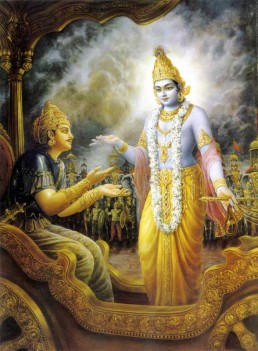WORSHIP OF THE DEVAS, THE TWICE-BORN, THE GURU, AND THE WISE — To maintain an attitude of attunement with a Higher-ideal, whereby the meditator develops in himself the qualities of the meditated, is called ‘worship.’ All cultural development, moral growth and ethical unfoldment can be accomplished only through these processes implied in ‘worship.’ It is almost like “the touch method” of magnetisation. One who is trying to come away from one’s inner personality-encumbrances must necessarily have an attitude of devotion and reverence towards the ideals represented in the Deva, the DEITY, worked out and lived by the TWICE-BORN, preached by the Guru and recommended by the WISE.
TWICE-BORN (Dwija) — The term indicates the Brahmins; and the term Brahmin means one who has realised the Self. Born as we are from the wombs of our mothers, we are all born as humans with certain intellectual beauties, no doubt, but also with many moral defects. Born out of the womb all right, but we are yet in the womb-of-matter! To hatch ourselves out of our matter-identifications and to emerge into the joy-of-Perfection is to grow into the Divine Estate of Godmen. This is conceived in our philosophy as the “second birth,” and one who has accomplished it is called the “twice-born,” and one who has accomplished it is called the “twice-born”: once born from the womb, and for a second time grown out of all the limitations suffered by the Spirit in Its seeming identifications with matter.
PURITY AND STRAIGHT-FORWARDNESS — The impor-tance of these two has been discussed earlier. External cleanliness, not only physical but also environmental, is an unavoidable qualification for a true aspirant. Unless a seeker diligently practises straight-forwardness in his dealings with others he will be developing in himself a split-personality, which will drain away all his composure, tranquillity and mental vitality.
BRAHMACHARYA — Constant revelling in the contemplation of the Supreme Brahman is called Brahmacharya This is not possible unless our nature is turned away from bodily indulgences in sense-objects and our minds are trained to turn inward to the Spirit. Therefore, all mental disciplines, by which we come to develop in us this introspection, are together comprehended by the term ‘Brahmacharya.’ Likewise, a medical college student is called a doctor, because he is applying himself to the direct means for becoming one, and the means are not far from the end.
NON-INJURY — This term has already been discussed many times very exhaustively. Refraining from bringing about any harm to others in society with the mind is called ‘non-injury.’ Physically, it is impossible for us to continue our existence without bringing, even unconsciously, some sort of injury to others, but our attitude can be changed, so that the seemingly unavoidable harm itself can bring about a great blessing to the world. A doctor ripping open a patient’s abdomen with a sharp knife, though doing an act of injury, can ultimately bring about a cure for the patient’s illness. Diligently avoiding all acts of injuring others from our emotional and intellectual realms is the strictest ‘non-injury’that can be practised in life.
All that has been so far explained constitutes bodily asceticism: physical austerity (Shaareeram Tapas).
Austerity (Tapas) is not a life of brutal self-denial only. On the other hand, it is an intelligent method of living in right relationship with the world-of-objects, thereby avoiding all unnecessary dissipations of our vital energies. The energies that are so economised and conserved are thereafter directed and employed in cultivating creative fields. This scheme — of discovering precious new energies, conserving them intelligently, and directing them into more profitable fields of spiritual enquiry — is called Tapas, self-control. Conservation of energy, and redirection of the same to fertilise fresh fields of cultivation within one’s own bosom are all meant herein, and the stanza concludes with a clear endorsement that this is true Tapas intelligently pursued at the body level.
TAPAS IN SPEECH IS NOW DESCRIBED:

